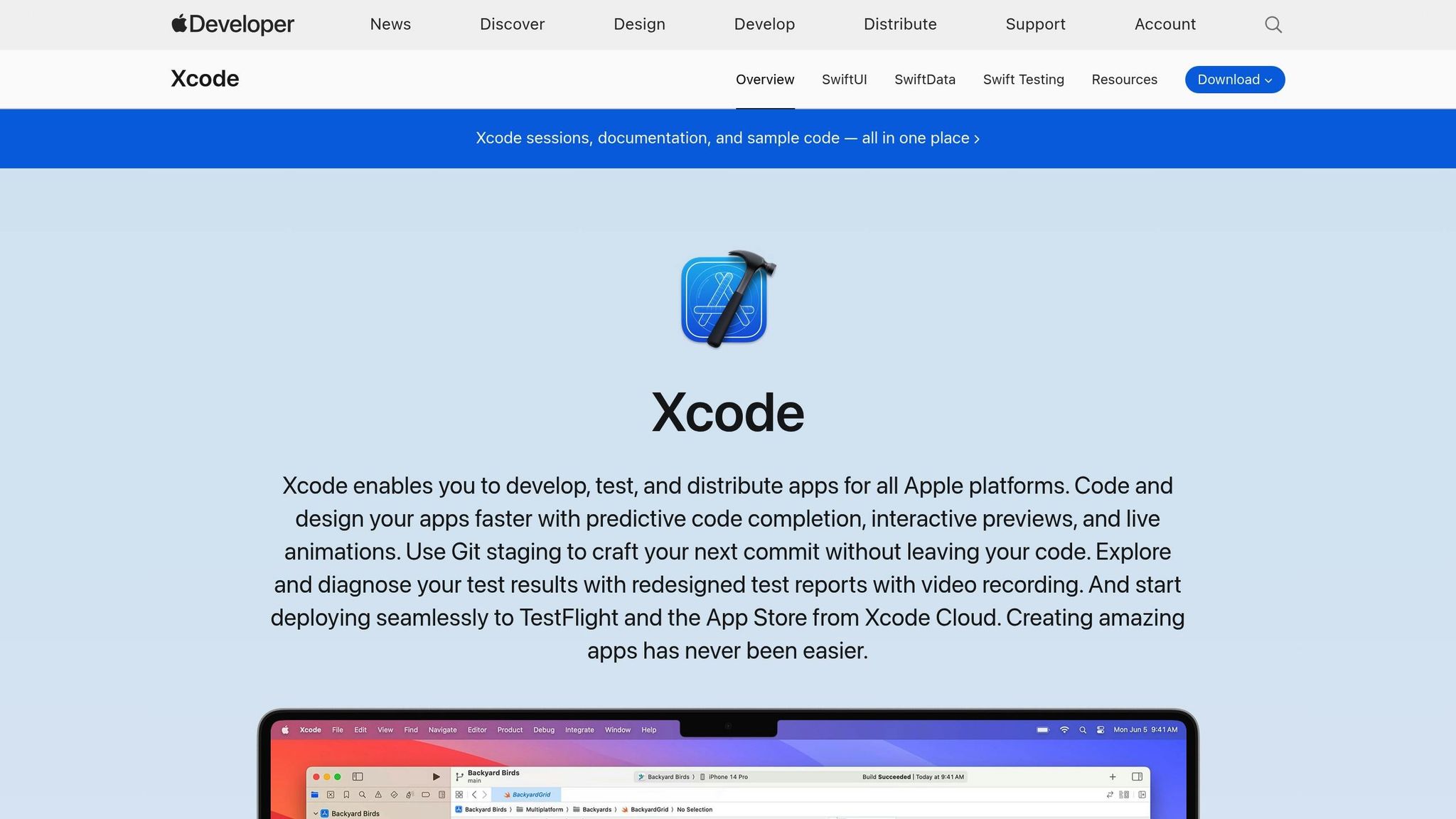Swift is a powerful programming language for building iOS apps that are both fast and secure. Here’s why it stands out:
- Speed: Swift runs up to 2.6x faster than Objective-C, making it ideal for high-performance apps.
- Safety: Features like automatic memory management, variable checks, and overflow protection reduce coding errors and improve security.
- Case Study: A healthcare app, SwiftMed, used Swift to securely handle sensitive patient data with encrypted APIs and authentication protocols.
- Optimization Techniques: Tools like ARC memory management, async/await for better responsiveness, and protocol-oriented programming improve app performance and modularity.
- Security: Integration of OAuth 2.0, biometric authentication, and zero-trust API security ensures strong data protection.
- Development Tools: Xcode’s performance testing tools and modular architectures streamline development and improve app reliability.
Swift combines speed, safety, and scalability, making it a top choice for creating modern, secure iOS apps.
Expert Advice to Learn iOS Dev & Swift FAST
Healthcare App Case Study: Speed and Security Improvements
Sidekick Interactive developed SwiftMed, a healthcare app that combines the efficiency of Swift with modern API methods to ensure secure data handling. Here’s a closer look at how SwiftMed achieves both reliable performance and strong data protection.
Healthcare Data: Managing Sensitive Patient Information
SwiftMed is designed to handle sensitive patient information while ensuring healthcare providers can access it quickly when needed. The app strikes a balance between maintaining fast performance and adhering to strict data privacy standards.
Technical Implementation: Swift and Secure API Integration
The development team used a two-layered API approach to enhance both security and functionality:
| Security Feature | Implementation Details | Benefit |
|---|---|---|
| GraphQL API | Custom GraphQL API for data storage | Efficient management of medical and user data |
| Secure Endpoint API | Isolated API gateway | Improved privacy through restricted data access |
| Authentication | Secure authentication protocols | Ensures only authorized access to sensitive data |
Swift Code Optimization Techniques
Learn how to improve performance and security in Swift programming. These practices are essential for building fast and secure iOS apps.
ARC Memory Management
Automatic Reference Counting (ARC) is Swift’s built-in system for managing memory. It automatically removes unused objects, helping to prevent memory leaks and maintain performance. To make the most of ARC, consider these strategies:
| Strategy | Implementation | Impact |
|---|---|---|
| Value Type Usage | Use structs and enums over classes | Avoids unintended sharing of data |
| Reference Management | Use weak or unowned references strategically | Prevents retain cycles |
| Lifetime Optimization | Enable Xcode 13’s "Optimize Object Lifetimes" | Improves ARC’s efficiency |
Additionally, Swift’s async/await feature simplifies handling asynchronous tasks, further enhancing app performance.
Swift Async/Await Implementation
Responsive interfaces are critical for iOS apps, especially when running tasks in the background. Swift’s async/await makes asynchronous programming more straightforward and easier to maintain. For example, in the SwiftMed app, using async/await reduced a key asynchronous routine’s code by nearly 70%, significantly improving responsiveness. This mirrors insights shared at WWDC21:
"Async/await in Swift can help out. Using it, you can write asynchronous code just as easily as you write regular code. And when you do, your code will better reflect your ideas. It’ll be safer too." – Nate, Apple Engineer
Protocol-Based Programming Methods
Protocol-oriented programming shifts the focus from class inheritance to defining behaviors through protocols. This approach improves modularity and type safety. Key advantages include:
| Feature | Benefit | Example |
|---|---|---|
| Protocol Extensions | Add functionality without altering types | Shared networking protocols |
| Multiple Protocol Conformance | Build flexible features by combining protocols | Authentication and data handling |
| Type-Safety | Catch errors at compile time | Enforce strict API interfaces |
"Don’t start with a class, start with a protocol." – Apple
sbb-itb-7af2948
Secure API Integration Methods
Creating faster and safer native apps requires secure API integration that meets strict standards. Data reveals a 53% increase in security breaches from Q1 2023 to Q1 2024.
API Security Standards
OAuth 2.0 is a cornerstone for secure API authorization. Its implementation relies on several critical components:
| Component | Purpose | Implementation |
|---|---|---|
| Access Tokens | Short-term authorization | Use JWT format with limited scope |
| Refresh Tokens | Maintain sessions | Store securely with encryption |
| OAuth Scopes | Control permissions | Define granular access permissions |
Biometric authentication, like Face ID or Touch ID via Apple’s LocalAuthentication framework, adds another layer of security.
"Traditional Access Tokens or Bearer tokens are very common but come with some vulnerabilities. In a typical token-based architecture, it would be enough to present a Bearer Token to gain access to protected resources." – Jonas Iggbom, Director of Sales Engineering, Curity
These measures work alongside robust data validation protocols to enhance security.
Data Validation Systems
For industries like healthcare, maintaining HIPAA compliance requires rigorous data validation. Effective practices include:
| Validation Type | Purpose | Implementation Method |
|---|---|---|
| Schema Validation | Ensures structural integrity | Use JSON Schema validation |
| Input Sanitization | Prevents injection attacks | Apply regular expression filters |
| Data Encryption | Protects sensitive information | AES-256 encryption |
In 2023, a major US healthcare provider integrated secure patient-doctor interactions using encrypted databases, cache systems, and JWT standards for data exchange – all while adhering to HIPAA regulations.
Strong validation systems lay the groundwork for adopting zero-trust principles in API security.
API Zero-Trust Security
A zero-trust approach further strengthens API security with measures like:
| Security Feature | Benefit | Implementation Detail |
|---|---|---|
| Certificate Binding | Prevents token theft | Use thumbprint verification |
| Mutual Authentication | Establishes two-way trust | Exchange certificates between client and server |
| Token Constraints | Limits token usage | Bind tokens to specific clients |
"Leveraging mTLS can enhance security in a token-based architecture. Using mTLS in the step where a client (server) requests an access token from a Token Service allows the Token Service to issue a token that is bound to that client (certificate) specifically and cannot be used by anyone else." – Jonas Iggbom, Director of Sales Engineering, Curity
Healthcare applications benefit greatly from zero-trust security, ensuring sensitive medical data is protected while meeting HIPAA requirements. Real-world implementations include encrypted databases, secure cloud storage, and advanced key management systems using hardware security modules (HSMs).
Development Tools for iOS Performance
Optimizing performance in iOS apps requires advanced tools that provide detailed insights and automation. These tools work alongside Swift’s built-in optimizations to ensure apps run smoothly and securely. They are essential for implementing the advanced Swift techniques discussed earlier.
Xcode Performance Testing

Xcode Instruments includes several tools to monitor and improve performance:
| Tool | Function | Benefit |
|---|---|---|
| Time Profiler | Tracks CPU usage | Pinpoints execution bottlenecks |
| Allocations | Monitors memory usage | Helps detect memory leaks |
| Zombies | Debugs memory issues | Prevents crashes from deallocated objects |
For example, using Time Profiler in a case study helped reduce main thread processing time, eliminating UI freezes. This kind of analysis aligns with Swift’s goal of delivering fast app behavior while maintaining security.
Module-Based Architecture
Many leading companies use modular architectures in their iOS apps. This approach provides several performance benefits:
| Benefit | How It Works | Result |
|---|---|---|
| Faster Compilation | Rebuilds only necessary modules | Cuts down build times |
| Parallel Development | Teams work on separate modules | Speeds up development |
| Memory Efficiency | Isolates resources per module | Improves build efficiency |
To maximize these benefits, modules should have minimal dependencies. This structure not only speeds up development but also makes it easier to maintain secure and scalable code – key requirements for modern iOS applications.
Automated Development Pipeline
Integrating performance tools into an automated development pipeline enhances overall efficiency and reliability. Key components of CI/CD pipelines include:
| Component | Purpose | Example Tool |
|---|---|---|
| Build Automation | Ensures consistent builds | Fastlane |
| Automated Testing | Maintains quality | XCTest, EarlGrey |
| Deployment | Manages releases | GitHub Actions |
For instance, combining GitHub Actions with Fastlane automates builds, tests, and deployments, reducing manual tasks and errors. Secure practices like protecting API keys, using containerized builds, and ensuring robust test coverage further reduce risks and manual effort.
"Implementing CI/CD for iOS development is a strategic move that enhances the efficiency, reliability, and collaboration within development teams. By automating repetitive tasks, developers can focus on creating high-quality code, resulting in faster releases and a more robust application." – Ahmed Elmemy
Conclusion: Benefits of Professional iOS Development
Professional iOS development offers clear advantages in performance and security. With nearly 90% of users abandoning slow apps, having skilled Swift developers is crucial for creating apps that perform well throughout their lifecycle.
Swift’s modern design can improve performance by up to 3.9x. When combined with experienced teams, it ensures apps are fast, scalable, and responsive. Techniques like proper memory management and asynchronous handling help avoid issues like memory leaks and UI freezes. These outcomes reflect the benefits of optimized Swift practices and secure API integrations.
Security is a top priority, especially as Apple rejected over 40,000 apps in 2022 for privacy violations. Professional developers implement robust security measures, such as:
| Security Layer | Implementation | Business Benefit |
|---|---|---|
| Data Protection | Encryption and secure key management | Builds user trust and ensures compliance |
| Network Security | HTTPS, SSL/TLS, and certificate pinning | Protects data during transmission |
| Authentication | Face ID and Touch ID integration | Strengthens security while improving user experience |
Apple’s US market share increased from 39% to 42%, highlighting the growing demand for well-developed iOS apps. A structured approach, from planning to deployment, ensures apps are secure, scalable, and perform exceptionally well.
FAQs
How does Swift’s performance stack up against other programming languages for iOS app development?
Swift is engineered for speed and efficiency, offering performance comparable to C-based languages and Objective-C. It’s optimized for modern hardware and takes advantage of Apple’s ecosystem, ensuring fast execution and smooth user experiences.
With its focus on safety and performance, Swift minimizes common coding errors while delivering robust, high-performing native iOS apps. This makes it an ideal choice for building apps that prioritize both speed and reliability.
What security measures does SwiftMed use to safeguard sensitive healthcare data?
SwiftMed employs a variety of robust security measures to protect sensitive healthcare data and ensure compliance with industry standards. These include end-to-end encryption, which secures data during transmission, and secure API integrations to safeguard communication between systems. Additionally, SwiftMed follows HIPAA-compliant protocols to meet stringent U.S. healthcare data protection requirements.
Other measures include regular security audits, data anonymization techniques, and implementing multi-factor authentication (MFA) to prevent unauthorized access. These strategies ensure that both patient data and system integrity remain protected at all times.
How do Swift features like async/await and ARC improve app performance and security?
Swift’s async/await and Automatic Reference Counting (ARC) are key tools for creating faster, more secure apps. The async/await feature simplifies handling asynchronous tasks, like fetching data from APIs, by making code cleaner and easier to manage. This improves app responsiveness and ensures smooth user experiences.
Meanwhile, ARC automatically manages memory by tracking and releasing unused objects, preventing memory leaks and improving app stability. By reducing manual memory management errors, ARC helps developers write safer, more efficient code. Together, these features allow Swift developers to build apps that are both high-performing and secure.

